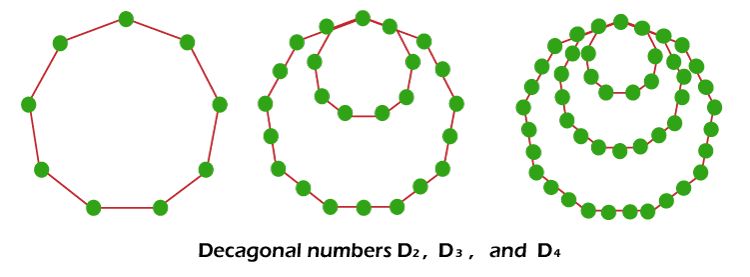Decagonal Numbers in JavaIn this section, we will learn what is Decagonal number and also create Java programs to that calculates the Decagonal number. The Decagonal number program is frequently asked in Java coding interviews and academics. Decagonal NumberA decagonal number is a figurate number, which is recursively defined as: 
Thus, D(1) = D(1 - 1) + 8 * 1 - 7 = D(0) + 8 - 7 = 0 + 8 - 7 = 0 + 1 = 1 D(2) = D(2 - 1) + 8 * 2 - 7 = D(1) + 16 - 7 = 1 + 16 - 7 = 1 + 9 = 10 D(3) = D(3 - 1) + 8 * 3 - 7 = D(2) + 24 - 7 = 10 + 24 - 7 = 10 + 17 = 27 D(4) = D(4 - 1) + 8 * 4 - 7 = D(3) + 32 - 7 = 27 + 32 - 7 = 27 + 25 = 52 D(5) = D(5 - 1) + 8 * 5 - 7 = D(4) + 40 - 7 = 52 + 40 - 7 = 52 + 33 = 85 Fined Decagonal NumberThere are various approahes to find the decagonal number. In this section, we will discuss the following three approaches:
Using RecursionAs we already know the recursive formula, it is easy to find the decagonal numbers using recursion. The following program shows the same. FileName: DecagonalNumbers.java Output: The first 10 Decagonal numbers are: 1 10 27 52 85 126 175 232 297 370 Complexity Analysis: As the recursion goes from n to 0 for finding the decagonal numbers, therefore, the time complexity of the program is O(n), where n is the nth decagonal number. As the program is not using any extra space, therefore, the space complexity of the program is O(1). The time complexity of the above program can be reduced further as we are computing the same subproblem again and again. For example, if we compute D(3), then recursively, D(3) gets reduced to D(2), which in turn gets reduced to D(1). Thus, we see that D(2) and D(1) are computed again, and this can be avoided. The following approach shows the same. Using Dynamic ProgrammingWe can use an auxiliary array for storing the computed decagonal numbers and can use them in further computation. Observe the following program. FileName: DecagonalNumbers1.java Output: The first 10 Decagonal numbers are: 1 10 27 52 85 126 175 232 297 370 Complexity Analysis: The time complexity of the program is O(1). As the program is using an Auxiliary array, therefore the space complexity of the program is O(range), where the range is the value up to which the decagonal numbers are computed. If we observe the recursive formula, we find that the current decagonal number is dependent on the last computed decagonal number only and not on all of the previously computed decagonal numbers. Therefore, instead of an array, we can use a variable for storing the previously computed decagonal number. Observe the following program. FileName: DecagonalNumbers2.java Output: The first 10 Decagonal numbers are: 1 10 27 52 85 126 175 232 297 370 Complexity Analysis: The time complexity of the program is O(1). As the program is not using any extra space, therefore the space complexity of the program is constant, i.e., O(1). Using Mathematical FormulaThe mathematical formula for computing the decagonal numbers are: Thus, D(1) = 1 x ((4 x 1) - 3) = 1 x (4 - 3) = 4 - 3 = 1 D(2) = 2 x ((4 x 2) - 3) = 2 x (8 - 3) = 2 x 5 = 10 D(3) = 3 x ((4 x 3) - 3) = 3 x (12 - 3) = 3 x 9 = 27 D(4) = 4 x ((4 x 4) - 3) = 4 x (16 - 3) = 4 x 13 = 52 D(5) = 5 x ((4 x 5) - 3) = 5 x (20 - 3) = 5 x 17 = 85 ImplementationObserve the implementation of the above mathematical formula. FileName: DecagonalNumbers3.java Output: The first 10 Decagonal numbers are: 1 10 27 52 85 126 175 232 297 370 Complexity Analysis: The time complexity of the program is O(1).
Next TopicJava Binary to Hexadecimal Conversion
|
 For Videos Join Our Youtube Channel: Join Now
For Videos Join Our Youtube Channel: Join Now
Feedback
- Send your Feedback to [email protected]
Help Others, Please Share










